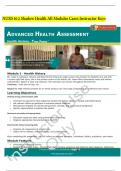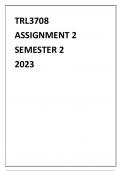A DVANCED H EALTH A SSESSMENT
“ I got this scrape on my foot a while ago, and I thought
it would heal up on its own, but now it’s looking
pretty nasty. And the pain is killing me!
Module 1 - Health History
Ms. Jones is a pleasant, 28-year-old obese African American single woman who presents to establish care and with
a recent right foot injury. She is the primary source of the history. Ms. Jones offers information freely and without
contradiction. Speech is clear and coherent. She maintains eye contact throughout the interview.
Timeframe: 1 week after fall (Age: 28)
Reason for visit: Patient presents for an initial primary care visit today complaining of an infected foot wound.
Learning Objectives
Develop strong communication skills
•
•
•
s e
Interview the patient to elicit subjective health information about her health and health history
Ask relevant follow-up questions to evaluate patient condition
Demonstrate empathy for patient perspectives, feelings, and sociocultural background
•
•
r
Document accurately and appropriately
U
Identify opportunities to educate the patient
Document subjective data using professional terminology
•
o
Organize appropriate documentation in the EHR
t
Demonstrate clinical reasoning skills
•
•
c l y
Organize all components of an interview
u
Assess risk for disease, infection, injury, and complications
rt On
After completing the assessment, you will reflect on personal strengths, limitations, beliefs, prejudices, and values.
Module Features
•
•
n s
Information Processing Activity
Student Performance Index - This style of rubric contains subjective and objective data categories. Subjective
I
© Shadow Health® 062015 || ShadowHealth.com
**For instructor use only**
Page 1 of 3
, data categories include interview questions and patient data. Objective data categories include examination
and patient data.
High Priority Low Priority:
• Acute pain of the foot • Acanthosis nigricans • Menorrhagia
• Local infection of skin and • Asthma • Obesity
subcutaneous tissue of the foot • Dysmenorrhea • Oligomenorrhea
• Uncontrolled type 2 diabetes • Hirsutism • Polycystic ovarian syndrome
mellitus • Hypertension
© Shadow Health® 062015 || ShadowHealth.com
**For instructor use only**
Page 1 of 3
,ADVANCED HEALTH ASSESSMENT
Health History - TINA JONES™
History of Present Illness
One week after sustaining the cut, Tina Jones develops an infection in the cut on the bottom of her foot; she seeks
treatment when the infection starts to swell and produce pus.
Day 1 (Onset): Tina was at home, going down the back steps, and she tripped. She turned her ankle and scraped the
bottom of her foot. The wound bled, but she stopped the bleeding quickly and cleaned the wound. She worried that
she had sprained her ankle, and her mom drove her to the ER. (“a week ago”)
The ER did an xray (no broken bones), gave her a prescription for Tramadol, and sent her home. In the following days,
her ankle seemed fine not as serious as she thought.
Day 2 - 4: She cleaned the wound dutifully, twice a day, with soap and water or hydrogen peroxide, let it dry, put
Neosporin on it, and bandaged it. The wound wasn’t getting worse, but it wasn’t healing, either. She expresses that
she “took really good care of it.” Tina was able to go to work and attend school.
Day 4: Tina went to her cousin’s house, where she encountered cats and experienced wheezing. She tried two puffs on
her albuterol inhaler, and she had to do a third puff. (“three days ago”)
Day 5 - 6: Tina noticed pus in the wound, and swelling, redness and a warm feeling in her foot. Her pain increased to
the point she was unable to walk. She began to take the Tramadol to try to manage the pain, but it didn’t resolve the
pain completely. She missed class and work. (“two days ago”)
s e
On the night of Day 6: Tina started to run a fever. They took her temperature at home, and it was 102. (“last night”)
Morning of Day 7: Tina finally recognizes that her foot infection is not going to get better, and her mom takes her to
the nurse practitioner to get the foot looked at.
U
Subjective and Objective Model Documentation
Printable “Answer Key” available within the Shadow Health DCE.
Chief Complaint
r
•
•
t o
Symptoms - Foot pain and discharge
Diagnosis - Infected foot wound
c y
Vitals
l
• Weight (kg) - 88
• Pulse Oximetry - 99%
u
• BMI - 30.5
• Blood Pressure (BP) - 139/87
n
• Heart Rate (HR) - 82
rt
• Blood Glucose - 117
• Respiratory Rate (RR) - 16
• Temperature (F) - 98.9
Medications
n s O
1. Acetaminophen 500-1000 mg PO prn (headaches)
2. Ibuprofen 600 mg PO TID prn (menstrual cramps)
3. Tramadol 50 mg PO BID prn (foot pain)
4. Albuterol 90 mcg/spray MDI 2 puffs Q4H prn (last
use: “a few months ago”)
Allergies
•
•
•
I
Penicillin: rash
Denies food and latex allergies
Allergic to cats and dust. When she is exposed to
allergens she states that she has runny nose, itchy and
swollen eyes, and increased asthma symptoms.
© Shadow Health® 062015 || ShadowHealth.com
**For instructor use only**
Page 1 of 3
, ADVANCED HEALTH ASSESSMENT
Health History - TINA JONES™
Abnormal Findings
Reported during Chief Complaint interview Reported during Past Medical History interview
• Reports open foot wound and throbbing pain • Diagnosed with asthma in childhood and uses an
• Rates present pain at a 7 out of 10 inhaler 2 to 3 times per week
• Discharge, redness, swelling, and warmth around • Allergic to penicillin, dust and cats, which cause
foot wound wheezing
• Reports a fever last night and presents with a fever • Diagnosed with Type 2 diabetes
of 101.1 F • Does not currently take medication for diabetes and
• Pain affects ability to walk, job performance, and does not monitor blood glucose
class attendance • Heavy menstrual flow, heavy cramping, and irregular
periods
• Occasional headaches and eye strain
• Increased thirst and more frequent urination
• Recent 10lb unintentional weight loss
• Habitual diet soda drinking
Assessment
Right foot wound with evidence of infection
Plan
1. Clean wound with normal saline and redress with clean gauze.
s e
2. Educate patient on when to seek emergent care, signs and symptoms of infection, and daily wound care.
U
3. Return to clinic one week to re-evaluate wound and assess need for antibiotics.
o r
c t y
u
rt On l
n s
I
© Shadow Health® 062015 || ShadowHealth.com
**For instructor use only**
Page 1 of 3





